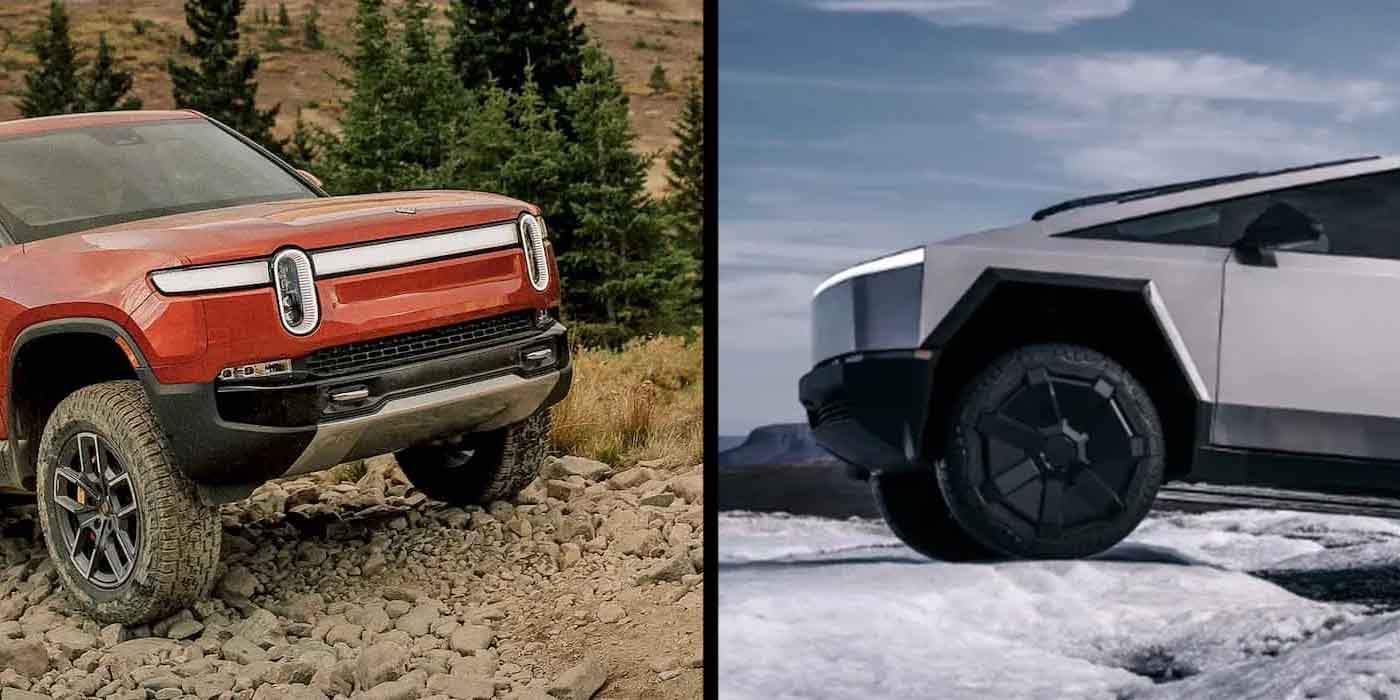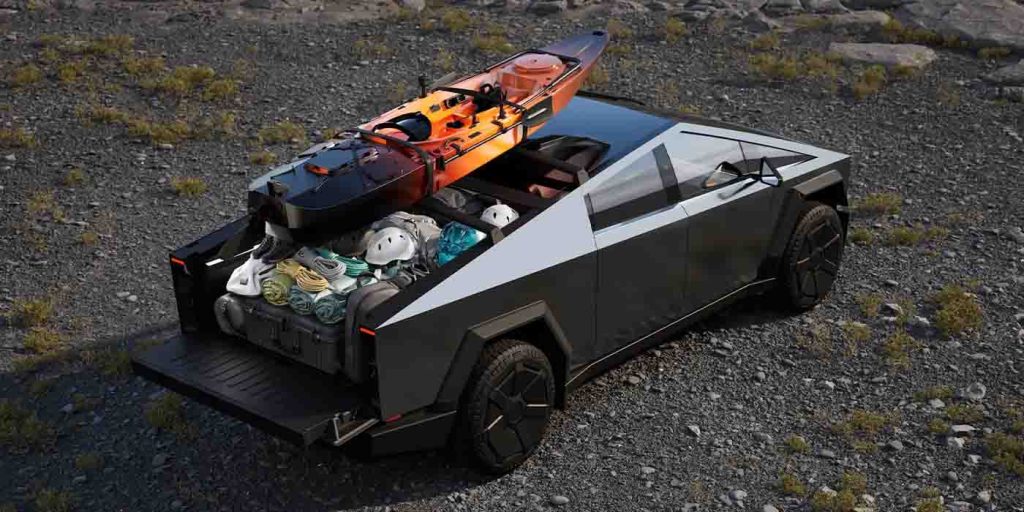
Following several new documents containing details of the Tesla Cybertruck posted to the EPA’s website, we have been able to better understand the efficiencies the truck will achieve. While Cybertruck should perform better than nearly all its current competitors in the electric pickup segment, the slightly smaller Rivian R1T appears to have it beaten – even with larger wheels and battery packs.
After years of waiting and speculating, Tesla finally launched its long-promised Cybertruck pickup last week to mixed reviews. On the one hand, the truck has seen some welcomed improvements since its initial debut – for instance, its tough exterior, 48V low voltage system, and, of course, windows that didn’t shatter this time around.
However, the Cybertruck arrives at a much higher price point than originally promised, with significantly less range, leaving a bad taste in the mouths of some reservation holders who had been waiting years for their opportunity to purchase the truck.
The Cybertruck enters a relatively niche but growing electric pickup segment in the automotive industry, now competing against the likes of the GMC Hummer EV, Ford F-150 Lightning, and the Chevy Silverado EV. Another American EV automaker in its own right is Rivian, whose flagship R1T pickup has been on the market longer than all the above and has a demand higher than ever.
Another factor higher than the pickups mentioned above is Rivian’s efficiency, which, on paper, bests Tesla’s Cybertruck, no matter what variant it’s using.

Cybertruck specs show efficiency second to only Rivian
As pointed out by Reddit u/Wugz, a slew of new Cybertruck documents were recently uploaded to the EPA’s website. Have a look here:
- Initial EPA Application for Tesla Cybertruck Beast
- Initial EPA Application for Tesla Cybertruck AWD
- Certificate Summary Information Report for Tesla Cybertruck Beast
- Certificate Summary Information Report for Tesla Cybertruck AWD
As the post points out from the documents above, both of the higher-tier versions of the Cybertruck feature a battery pack of 816 V and 150 Ah. That should translate to approximately 122.4 kWh, which makes sense given that the talking point for the truck’s actual battery capacity has been the slightly embellished 123 kWh. For comparison to the Cybertruck, Rivian’s Max pack and Large pack are 149 kWh and 135 kWh, respectively.
We’ll briefly touch on the Cybertruck’s motors but recommend not focusing too much on it because the EPA and Tesla are saying different things. The certificate summary says the Cybertruck AWD will have two permanent magnet motors, while the initial EPA application says one induction motor and one permanent magnet. For Beast, both documents say three permanent magnets, although Tesla has said it will consist of two rear induction motors and one permanent magnet in the front. So, who’s correct?
Here’s where things get interesting. Based on the coastdown tests conducted by Tesla as part of its EPA certification process, u/Wugz was able to compare the Cybertruck to the Rivian R1T, as well as the other pickups mentioned above. While Cybertruck bests Chevy, Ford, and GMC, it can’t touch Rivian, especially over 70 mph:
| Pickup Model/Variant | 50 mph | 70 mph |
| Rivian R1T Performance Dual Motor Max Pack (21″) | 151 Wh/mi | 233 Wh/mi |
| Rivian R1T Performance Dual Motor Max Pack (22″) | 172 Wh/mi | 258 Wh/mi |
| Rivian R1T All-Terrain Dual Motor Large Pack (20″) | 184 Wh/mi | 273 Wh/mi |
| Tesla Cybertruck AWD (20″) | 161 Wh/mi | 272 Wh/mi |
| Tesla Cybertruck Beast (20″) | 168 Wh/mi | 278 Wh/mi |
| Chevrolet Silverado EV 4WT (18″) | 188 Wh/mi | 300 Wh/mi |
| Ford F-150 Lightning Platinum (22″) | 177 Wh/mi | 303 Wh/mi |
| GMC Hummer EV Pickup Tri-Motor (22″) | 218 Wh/mi | 378 Wh/mi |
Obviously, several factors play into this, and Cybertruck’s initial data could change as time goes on. However, Rivian is a clear leader in pickup efficiency at this current point. A big reason for that is sheer aerodynamics – the Rivian R1T has a Cd of 0.30 compared to 0.335 on the Cybertruck. In this sense, Tesla will never be able to compete with Rivian on aerodynamics, especially since it is simply a larger EV with more frontal surface area. Still, Cybertruck blows away the Lightning and Hummer on Cd (0.44 and 0.50, respectively). The Chevy Silverado EV is closer at a 0.331 Cd.
Air resistance is a function of velocity squared, so while the differences may be mostly negligible at 45mph, as the vehicles grow to 60mph and beyond, the Rivian will take an increasingly bigger lead.
One last tidbit to point out in this data-driven comparison between the Tesla Cybetruck and the Rivian R1T is the range tests themselves and the correction factors used by each automaker. Tesla already has a reputation for using rather high correction factors to publicize better range that its EVs usually offer – and the Cybertruck appears to be Tesla’s most optimistic formula to date. Tesla’s factors are estimated to be 0.82 for the AWD truck to reach a 340-mile range and 0.79 for the Beast to get a range of 320 miles.
If Tesla used the industry norm of .7 that other manufacturers adhere to, the Cybertruck range would be about 290 miles for AWD and the Beast would get 283.5. Those are still impressive distances for the 122.4kWh battery and what owners should expect in real-world range.
Top comment by ddomi021
Wonder how this would play out if Tesla offered a version without off road tires, Seems like it makes a big difference in Rivians case where despite of the larger rims, the performance model is more efficient than the all-terrain, presumably due to the tires. I bet the CT would be more efficient with the 18" tires that were being offered on the app as an accessory. In fact, if we compare 20" both with All terrain tires, the Rivian and CT are quite close, 272 wh/mi vs 273 wh/mi respectively. CT is ugly but it also has a 6-foot bed where Rivians are 18" shorter. That makes Rivians bed only 6" longer than the CT with the questionable battery pack assuming it takes up 1/3 of the CT bed.
For comparison, Rivian’s correction factor, as is most of the rest of the industry, on the R1T is 0.70 – which is much more conservative and likely closer to real-world range estimates. Tesla might be able to deliver more range with its 50kWh range extender pack, although it appears Rivian owns the patent for that.
So, to recap, the Rivian R1T has larger batteries, wheels, and a lower correction factor in estimating range, yet it still delivers better efficiency than Cybertruck (according to Tesla’s recent EPA filings, of course).
There are a lot of variables at play here, so don’t shoot the messenger just yet. Even if Cybertruck does take silver in efficiency behind Rivian, its specs remain some of the best in the segment right now. That includes its size, which bests the Rivian in some key areas. That should still be considered a win, especially with its polarizing design.
And the Cybertruck still wins the polygonal contest, so Tesla fans still have that.
FTC: We use income earning auto affiliate links. More.

Comments